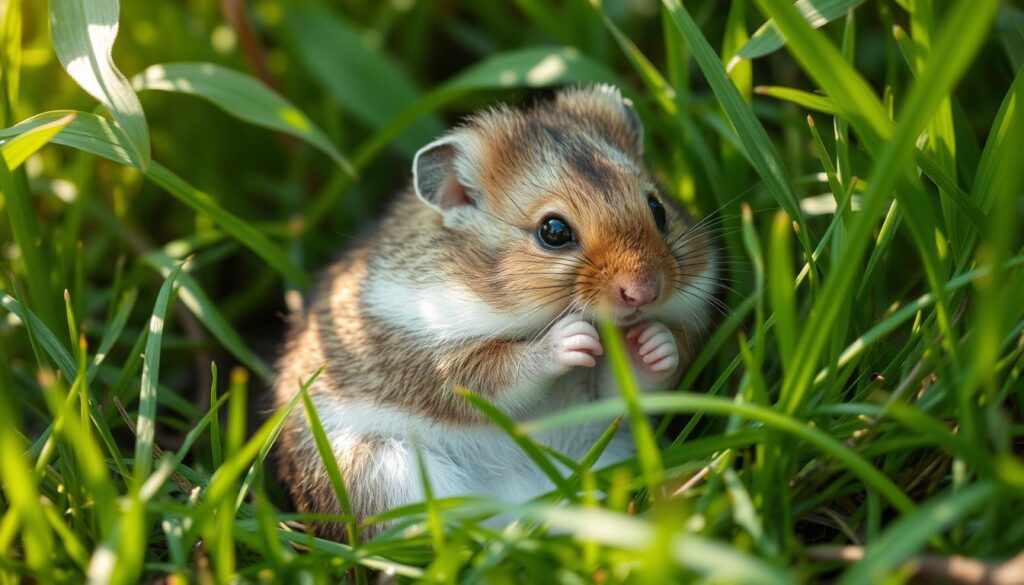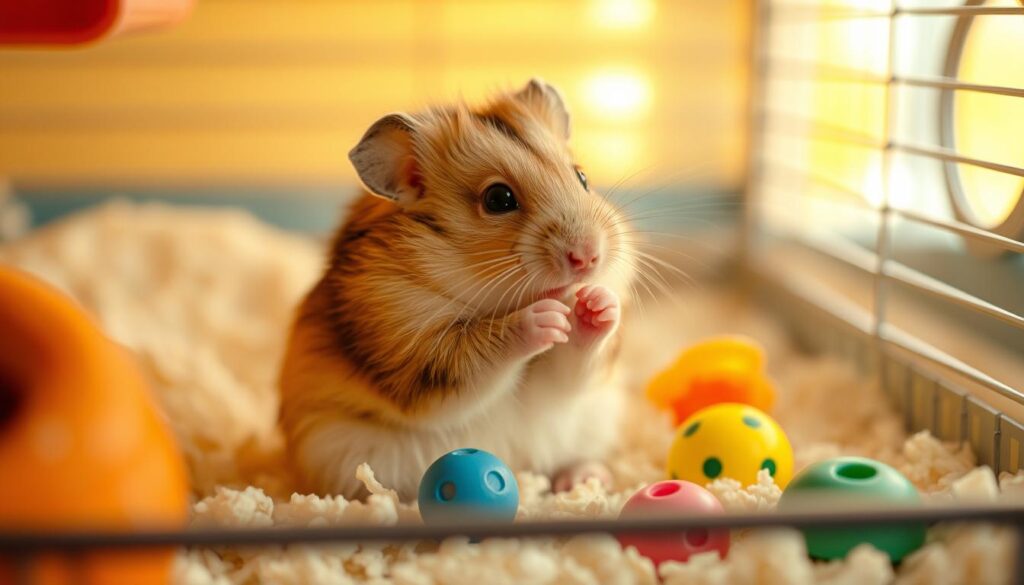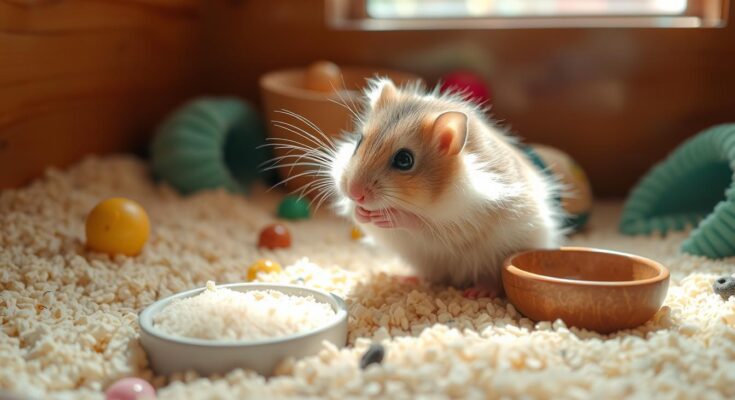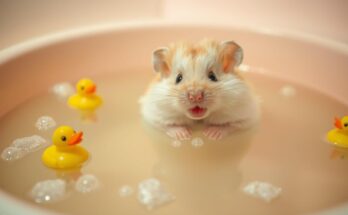I’ve always been fascinated by hamsters’ grooming habits. Up to 20% of their time is spent cleaning themselves, which keeps their fur looking great and helps them stay healthy.
In this guide, we’ll dive into hamsters’ grooming habits and the role of sand baths. We’ll also talk about when you might need to help your hamster stay clean. Keeping your hamster clean is key to their happiness and health.
Key Takeaways
- Hamsters are highly fastidious animals, spending up to 20% of their time grooming themselves.
- Proper bedding changes, cage cleanings, and accessory maintenance are key for hamster hygiene.
- Sand baths can be a safe way to help hamsters clean while brushing helps remove debris.
- Long-haired hamster breeds may need extra grooming as they get older.
- It’s wise to see a vet if your hamster seems to be ignoring its grooming.
Understanding Natural Hamster Grooming Behaviors
Hamsters are great at cleaning themselves. They use their paws and teeth to spread oils in their fur. This keeps their skin and fur healthy.
They groom after being handled. This removes human scent and adds back protective oils.
Self-Grooming Techniques
Hamsters know how to groom themselves well. They use their paws to comb their fur. Their teeth help with hard-to-reach spots.
They also lick their paws and then wipe their face and ears. This ensures they are clean all over.
When Hamsters Typically Clean Themselves
Hamsters are most active at night and early morning. This is when they groom the most. They spend minutes cleaning their fur to keep it soft and shiny.
The Role of Protective Oils
The oils in a hamster’s fur are very important. They keep the fur waterproof and prevent it from drying out. Regular grooming helps spread these oils evenly.
| Grooming Behavior | Frequency | Purpose |
|---|---|---|
| Licking paws and wiping face | Several times per day | Cleaning head and facial area |
| Combing fur with front paws | Multiple times per day | Distributing natural oils and removing debris |
| Chewing on fur | Daily | Removing loose or damaged fur |
The Truth About Water Baths for Hamsters
Keeping your hamster clean is key. But, water baths aren’t always the best choice. Unless a vet says so, it’s best to avoid them.
Hamsters don’t like water and can get stressed or cold. Water baths can also harm their skin and coat. Instead, use pet-friendly wipes or a damp cloth to clean them, focusing on the rear end.
If a water bath is needed, use warm water and a safe shampoo. Dry your hamster in a warm, draft-free spot. Use chinchilla sand, not dust, to prevent health problems. A sand bath should last 15-20 minutes, given a few times a week.
| Hamster Bathing Recommendations | Ideal Frequency |
|---|---|
| Sand Baths | 2-3 times per week |
| Water Baths | Rare, only when advised by a veterinarian |
Regular grooming is vital for hamsters. This includes brushing, nail trims, and checking their skin and teeth. Knowing the truth about water baths for hamsters helps you care for them properly.
“Hamsters generally do not require soap and water baths unless advised by a vet. Dirty rear ends on hamsters can lead to urinary or reproductive issues.”
How Hamsters Clean Themselves in the Wild
In the wild, hamsters groom themselves in unique ways. They keep their coats clean and healthy without human help. Unlike pets, wild hamsters use natural methods to stay clean.
Natural Cleaning Methods
Wild hamsters often roll in sand or dust to clean themselves. This “dusting” helps remove dirt and spreads their skin oils. They also use their teeth and claws to clean hard spots.
Environmental Factors
Many wild hamsters live in dry places. This makes them use sand and dust baths to stay clean. It helps them stay healthy in their natural homes.
Instinctive Behaviors
Hamsters spend about 20% of their time grooming. They have special glands that make scent. This scent spreads through their fur, marking their territory and talking to other hamsters.
Knowing how wild hamsters groom is key for pet owners. Giving them sand or dust baths and encouraging grooming helps keep them clean and happy.

Benefits and Importance of Sand Baths
Hamsters, and dwarf breeds in particular, really benefit from sand baths. These baths help remove oils and dirt from their fur. They also help keep parasites away. Plus, they offer a fun way for hamsters to clean themselves, just like in the wild.
Experts say to give your hamster a sand bath a few times a week. Each bath should last about 15-20 minutes. It’s best to use chinchilla sand instead of dust to avoid health problems. Make sure the sand is deep enough for your hamster to dig and roll around in.
- Sand baths help decrease natural oils and dirt in a hamster’s coat
- May deter parasites and provide environmental enrichment
- Mimic natural cleaning behaviors and are a fun activity for hamsters
- Chinchilla sand is recommended over dust to reduce respiratory and eye issues
- Offer sand baths several times a week, with each session lasting 15-20 minutes
- Ensure the sand depth is at least an inch or two to allow for comfortable digging and rolling
Adding sand baths to your hamster’s grooming routine is key. It keeps their fur healthy and their body clean. This simple care is essential for your hamster’s well-being.
Choosing the Right Bathing Sand for Your Hamster
Keeping your furry friend clean and happy starts with the right bathing sand. Hamsters are meticulous groomers. They use sand baths to keep their coats and skin in good shape. But, not all sand is safe for them.
Types of Safe Bathing Sand
- Hamster-specific sand: Look for sand made for small pets like hamsters or chinchillas. It’s soft, absorbent, and dust-free. This keeps your hamster comfortable and safe to breathe.
- Chinchilla sand: If you can’t find hamster-specific sand, chinchilla sand is a good alternative. Just pick a coarser type to avoid breathing problems.
What to Avoid
Stay away from certain sands that can harm your hamster. Avoid beach sand because it’s coarse, dirty, and can have sharp particles that irritate your pet’s skin. Also, regular playground or construction sand is too fine and dusty. It can be bad for your hamster’s breathing.
Proper Sand Bath Setup
After picking the right sand, set up the perfect sand bath. Use a small, shallow dish or container. Fill it with about 1 inch of sand. This lets your hamster burrow, roll, and groom without making a mess.
Place the sand bath in a quiet, easy-to-reach spot in your hamster’s habitat.
With the right sand and setup, your hamster can have a healthy grooming routine. This keeps their coat shiny and their skin healthy. Always talk to your vet if you have any grooming or hygiene concerns.
Supporting Your Hamster’s Hygiene Routine
Keeping your hamster clean is key to their health. A regular grooming routine helps them stay clean and happy. Here are some easy tips to keep your hamster’s hygiene in check.
First, make sure their living space is clean. Change their bedding every week and deep clean their cage monthly. This stops bad smells and keeps them healthy.
Give them chew toys to keep their teeth and nails in shape. Chewing is natural for hamsters and keeps their teeth from getting too long. Always check their teeth and nails, but ask a vet for any dental care.
Brushing their fur is good for long-haired hamsters. It removes tangles and keeps their coat looking nice. Use a soft brush and don’t brush too hard.
Check for any skin problems or stains often. If you see something odd, see a vet right away. This keeps your hamster healthy and happy.
| Aspect | Recommended Frequency |
|---|---|
| Bedding Change | Weekly |
| Full Cage Cleaning | Monthly |
| Nail Trimming | As Needed |
| Coat Brushing | Periodic |
By following these hamster care tips, you can keep your hamster clean and happy. Remember, grooming and a clean home are vital for their health.

Special Grooming Needs for Long-Haired Hamsters
Caring for long-haired hamsters, like Teddy Bear hamsters, needs extra effort. They need regular brushing to keep their fur looking good and prevent tangles. Brushing them once a week helps remove dirt and food bits from their fur.
Brushing Techniques
When brushing a long-haired hamster, be gentle. Start by gently running your fingers through their fur to remove loose hair. Then, use a soft-bristle brush or grooming glove to brush in the direction of hair growth. Be careful with mats or tangles to avoid hurting them.
Managing Matted Fur
Even with regular brushing, long-haired hamsters can get matted fur, often in the rear. If mats are severe, see a vet or groomer. Trying to fix mats yourself can hurt their skin.
Preventive Care
Keeping a long-haired hamster clean is key to avoiding fur problems. In addition to brushing, give them safe bathing sand to roll in. This removes oils and keeps their fur clean. Also, feed them a balanced diet to keep their coat and skin healthy.
By following these grooming tips, you can keep your long-haired hamster, like a Teddy Bear hamster, happy and healthy. Remember, regular care is important for their well-being.
| Grooming Needs | Short-Haired Hamsters | Long-Haired Hamsters |
|---|---|---|
| Brushing Frequency | Minimal, only when needed | Weekly |
| Matting Concerns | Rare | A balanced diet with extra nutrients to support coat health |
| Bathing Sand Preference | Occasional | Weekly |
| Dietary Considerations | Standard hamster diet | Balanced diet with extra nutrients to support coat health |
Signs Your Hamster Needs Grooming Assistance
As a devoted hamster owner, it’s key to watch for signs your furry friend needs grooming help. Keeping your hamster clean is vital for their health and your living space. It makes your home cleaner and happier for both of you.
A dirty rear end is a clear sign your hamster needs grooming. If you see feces or matted fur, they can’t clean themselves well. Matted fur anywhere can trap dirt and parasites, causing skin problems and health issues.
Long nails are another warning sign. Hamsters’ nails grow and can become sharp if not trimmed. If your hamster’s nails are too long, it’s time to cut them or get vet help.
A sudden change in your hamster’s smell is also a sign. Hamsters are usually clean, so a change in smell means they need help.
If you see these signs or think your hamster can’t groom itself, see a vet. They can teach you how to groom your hamster and suggest treatments. This keeps your hamster’s health and grooming in great shape.
Being proactive about your hamster’s pet hygiene issues is important. It ensures their well-being and comfort. By quickly addressing grooming problems, you help your hamster stay healthy and happy.
Maintaining a Clean Habitat for Better Hygiene
Keeping your hamster’s home clean is key for their health. I clean their food and water spots every day to stop bad bacteria. I also swap out the bedding once a week but change dirty spots daily.
For a really clean space, I deep clean the cage monthly. I wash all toys and accessories with warm, soapy water. I dry everything completely before putting it back to avoid mold.
When it comes to baby hamsters, I clean their cage the same way. But I’m extra careful to move them safely during cleaning. This keeps them safe and stress-free.
Good hamster cage cleaning and pet habitat maintenance are vital. By doing these tasks regularly, I make sure my hamster lives in a clean, happy place.
FAQ
Q: How do hamsters typically clean themselves?
A: Hamsters are good at cleaning themselves. They use their hands and mouth to spread oils on their fur. This keeps their fur healthy.
They groom after being held to remove human scent. They also groom at night, when they are most active.
Q: When do hamsters usually clean themselves?
A: Hamsters groom themselves at night. They use natural oils to keep their fur and skin healthy.
Q: Can hamsters get water baths?
A: Water baths are not usually good for hamsters. They can get cold and lose important oils. If you need to clean them, use pet-friendly wipes or a damp cloth.
Be careful with the rear end to avoid stains.
Q: How do hamsters clean themselves in the wild?
A: In the wild, hamsters use sand to stay clean. They roll in sand to remove dirt and oils. Their dry habitats help them stay clean naturally.
Q: Why are sand baths important for hamsters?
A: Sand baths are key for hamsters, like dwarf breeds. They help remove oils and dirt. They also keep parasites away and are fun for hamsters.
Q: What type of sand should I use for my hamster’s bath?
A: Choose sand made for small pets like hamsters. It should be soft, absorbent, and free of dust. Avoid beach sand, which is dirty and coarse.
Q: How can I support my hamster’s hygiene routine?
A: Keep their living area clean by changing bedding weekly. Do a full cage cleaning every month. Give them chew toys for dental health.
Check for skin issues and groom their fur. Trim their nails when needed, but see a vet for dental care.
Q: Do long-haired hamsters have special grooming needs?
A: Yes, long-haired hamsters need extra grooming. Brush their fur often to prevent matting. Use gentle brushes to avoid skin problems.
For matted fur, carefully untangle it or see a vet if it’s bad.
Q: How do I know if my hamster needs grooming assistance?
A: Look for signs like dirty rear ends or matted fur. Also, watch for overgrown nails or a change in smell. If your hamster can’t groom itself, help out.
See a vet if you notice any unusual changes in your hamster.
Q: How do I maintain a clean habitat for better hamster hygiene?
A: A clean home is key for your hamster’s health. Clean food and water daily to stop bacteria. Change bedding weekly and do a full cage clean monthly.
Wash all accessories with warm, soapy water. Make sure everything is dry before putting it back in the cage.



